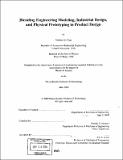| dc.contributor.advisor | Woodie C. Flowers. | en_US |
| dc.contributor.author | Page, Matthew E. (Matthew Edwin), 1975- | en_US |
| dc.contributor.other | Massachusetts Institute of Technology. Dept. of Mechanical Engineering. | en_US |
| dc.date.accessioned | 2005-09-26T19:14:06Z | |
| dc.date.available | 2005-09-26T19:14:06Z | |
| dc.date.copyright | 2000 | en_US |
| dc.date.issued | 2000 | en_US |
| dc.identifier.uri | http://hdl.handle.net/1721.1/28225 | |
| dc.description | Thesis (S.M.)--Massachusetts Institute of Technology, Dept. of Mechanical Engineering, 2000. | en_US |
| dc.description | Includes bibliographical references (leaves 63-64). | en_US |
| dc.description.abstract | Engineering simulation models, industrial design form models, and physical experimentation through prototypes are critical elements of successful product design. However, the three disciplines are disconnected and the direction of simulations, form models, and physical prototypes often diverge increasingly as product detail is developed. This divergence often results in an expensive and time consuming design cycle and inferior product quality. The first 10% of the cycle is taken up largely by conceptual design, an iterative stage that requires close interaction between industrial designers, modelers and engineers. In the current state of the art, information is often lost when models are approximately reconstructed from physical prototypes, CAD or surface models. A new approach to the conceptual design cycle is developed and applications for the design of consumer products are discussed. The tools that make up the cycle work together to create a flexible, iterative design environment. Industrial designers, engineers, and modelers generate and exchange form concepts, alternating between physical and digital representations of product geometry. Rapid alternation between the physical and digital domain is enabled and information flow between iterations is improved. | en_US |
| dc.description.statementofresponsibility | by Matthew E. Page. | en_US |
| dc.format.extent | 71 leaves | en_US |
| dc.format.extent | 4421428 bytes | |
| dc.format.extent | 4428663 bytes | |
| dc.format.mimetype | application/pdf | |
| dc.format.mimetype | application/pdf | |
| dc.language.iso | en_US | |
| dc.publisher | Massachusetts Institute of Technology | en_US |
| dc.rights | M.I.T. theses are protected by copyright. They may be viewed from this source for any purpose, but reproduction or distribution in any format is prohibited without written permission. See provided URL for inquiries about permission. | en_US |
| dc.rights.uri | http://dspace.mit.edu/handle/1721.1/7582 | |
| dc.subject | Mechanical Engineering. | en_US |
| dc.title | Blending engineering modeling, industrial design, and physical prototyping in product design | en_US |
| dc.type | Thesis | en_US |
| dc.description.degree | S.M. | en_US |
| dc.contributor.department | Massachusetts Institute of Technology. Department of Mechanical Engineering | |
| dc.identifier.oclc | 46972722 | en_US |
